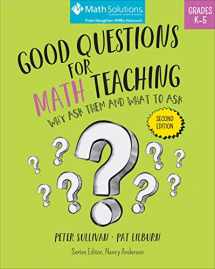
Good Questions for Math Teaching: Why Ask Them and What to Ask, Grades K–5, Second Edition
ISBN-13:
9781935099765
ISBN-10:
1935099760
Edition:
second edition
Author:
Peter Sullivan, Pat Lilburn
Publication date:
2020
Publisher:
Math Solutions
Format:
Paperback
224 pages
Category:
Education Theory
,
Schools & Teaching
FREE US shipping
Book details
ISBN-13:
9781935099765
ISBN-10:
1935099760
Edition:
second edition
Author:
Peter Sullivan, Pat Lilburn
Publication date:
2020
Publisher:
Math Solutions
Format:
Paperback
224 pages
Category:
Education Theory
,
Schools & Teaching
Summary
Good Questions for Math Teaching: Why Ask Them and What to Ask, Grades K–5, Second Edition (ISBN-13: 9781935099765 and ISBN-10: 1935099760), written by authors
Peter Sullivan, Pat Lilburn, was published by Math Solutions in 2020.
With an overall rating of 3.7 stars, it's a notable title among other
Education Theory
(Schools & Teaching) books. You can easily purchase or rent Good Questions for Math Teaching: Why Ask Them and What to Ask, Grades K–5, Second Edition (Paperback) from BooksRun,
along with many other new and used
Education Theory
books
and textbooks.
And, if you're looking to sell your copy, our current buyback offer is $0.48.
Description
Good Questions for Math Teaching
- What is a good question?
- How do I create a good question?
- How might I use a good question in my mathematics classroom?


We would LOVE it if you could help us and other readers by reviewing the book
Book review

Congratulations! We have received your book review.
{user}
{createdAt}
by {truncated_author}


